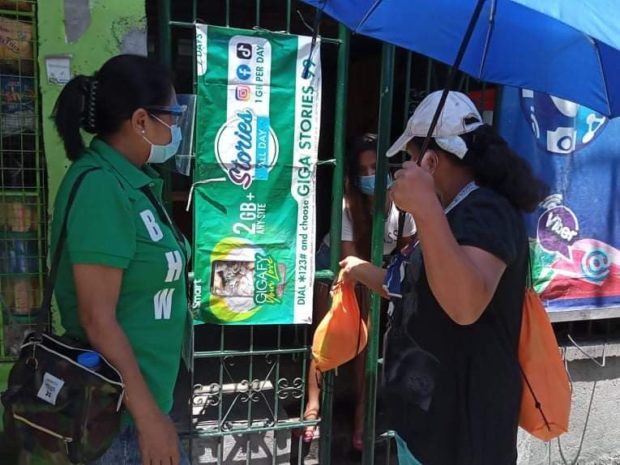
MODEL APPROACH: Barangay health workers in Barangay 28 in Caloocan City, distribute food packs while conducting house -o-house visits in the community. Their local health and emergency response team was able to establish a system that was later recognized as a model for COVID-19 containment, where the health workers took charge of data collection and contact tracing while ensuring that persons showing symptoms remained in quarantine. This photo was taken in September 2020. —CONTRIBUTED PHOTO
MANILA, Philippines — The Department of Health (DOH) on Saturday acknowledged a downtrend in COVID-19 cases but reported that technical issues continued to affect its reporting system.
Because of these issues, which the DOH did not specify, the number of recorded deaths caused by the respiratory disease remained unchanged since Thursday, when it stood at 37,405.
“The Department of Information and Communications Technology is currently addressing issues encountered by the system. When the issue is resolved, the succeeding increase in deaths in the following reports will be due to the previous days’ backlogs,” the DOH said. As for the other figures, the department said the total cases are generated from the COVID-19 Document Repository System data. Recoveries, on the other hand, were determined based on time-based guidelines—which meant that mild and moderate cases were considered recovered after 14 days.
Proper use
Explaining the slowdown in the increase in cases, Health Undersecretary Maria Rosario Vergeire said “we have some issues related to laboratory outputs. We have seen testing outputs go down.”
“We are also trying to analyze if the use of antigen tests is affecting our data,” she said at the Laging Handa briefing.
In April, amid a surge in COVID-19 cases attributed to the emergence of the more contagious Delta variant, the department was already calling for the use of the faster antigen tests in places where the RT-PCR (reverse transcription-polymerase chain reaction) test—considered the “gold standard”—was unavailable.
Vergeire then said that the DOH would study how to integrate positive antigen test results into the DOH tally.
But on Saturday, she raised some concerns regarding the use of antigen tests.
“Based on our recent analysis of the 6,000 plus that were submitted to us, when we validated this, only about 300 plus were used in the right way, so these are the only [antigen tests] that can be included [in the tally],” she said.
Vergeire also said there were specific situations for the proper use of antigen tests, such as when a household has a COVID-19 case.
But there were also instances when the use of antigen tests would be improper, she said, such as when screening travelers moving around the country and workers entering their workplaces.
“That is not the right or proper use of antigen tests, so we may get inaccurate results,” Vergeire said.
The DOH, however, has yet to come up with guidelines on when such tests may be applied.
Vergeire said the department would soon roll out a reporting system that would include antigen test results.
Virus case update
Saturday’s DOH bulletin reported 16,907 new infections, bringing the total count nationwide to 2,470,175.
There were 27,120 new recoveries, raising the total number of survivors to 2,267,678.
Of the 165,092 active cases, the majority, or 81.3 percent, are mild, 13.3 percent are asymptomatic, 3.1 percent are moderate, 1.6 percent are severe and 0.7 percent are critical.
The latest data showed a positivity rate of 23.6 percent, with 17,607 out of 74,606 tested on Thursday turning out positive.
The DOH said 76 percent of all intensive care unit beds, 70 percent of ward beds and 64 percent of isolation beds are currently occupied, while 55 percent of all mechanical ventilators are in use.
Four labs failed to submit their data on time, while 60 duplicate cases were removed from the total case count.

